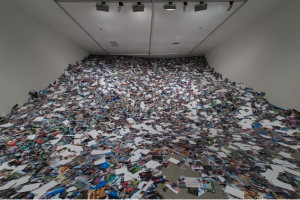As the digital era continues to expand more and more people have access to their own cameras whereas many years ago to become a photographer you had to be rich and now a lot about the science of the chemicals to create your own photographs.
“When people had family albums they used to be private and only for the eyes of the family. Now the role of the photograph has totally changed, we consume images everyday. The only this is that we don’t really digest them. They go in and they go out again.”- Erik Kessels.


I think the project really puts into persecutive just how many photographs we take everyday and it really made me think how photographs are used at peoples disposal.
The use of photography every day has made a lack of “iconic images” for example so many photographs have come out of the Iraq war but none of them are as iconic as those that have come out of previous wars. I think this because everyone has access to cameras now a days whether it be a phone camera or a digital point and shoot. The idea of the “iconic image is some what dying out now as so many people can now take photographs of everything. The time of just one photographer capturing a memory or iconic moment is almost gone due to fact that images can be captures so much faster and easier now.
The amount of images being uploaded to Facebook or instagram, etc makes people appreciate photographs less now because everyone has access to take their own images.
A change in assumptions, a new way of ordering and making sense of things (Thomas Kuhn, 1962)
What is the role of the professional within the 21st century photography?
In the digital age we live in there is a fine line between an amateur and professional photographer, those who are classed as “amateur” are able to buy the equipment that the professionals also use however without practice and research I feel that those amateur’s would still create interesting images but the professional will always have the power to create the better image.
One of the key roles to creating stunning images is being able to relate to your audience.
Copyright is key when it comes to keeping our own images to ourselves, however watermarking may not be the way to go.
It is easy to photoshop the watermark out of the image, however the safest way to copyright your image is to make people unable to copy them.
Creative Comments is a way of protecting your own images and essentially have full copyright but also allows people to share it but they must link back to my own website.
The importance of craft is seen in music, i.e. paying for albums rather than the MP3 can also be linked to photography. An example of this is the use of Instagram, a photographer can put the behind the scenes images onto Instagram but the actual photographs themselves will only be available in book form. This means that the photographer can give people a hint at what he or she are photographing and attract an audience but only if they pay for it can they have access to the real photos.
-How can we work with Amateur Photography?
– They can provide ideas and inspiration for images.
-They can show us not what to do.
The amateur photograph is sometimes just a quick snapshot and trying to create the clearest picture.
However the professional always tries to find that different angle and we look for a different style.
I think the professional photographer always goes that step further that some amateur’s either don’t see or wont go.
This sometimes makes the professional image that tiny bit better than the amateur however I think the line between professional and amateur is so thin that sometimes the amateur may appear to be a professional but in fact isn’t.I think that what defines the amateur and professional is the way in which they take there images and how they are thought out and created.
One thought on “Amateur Vs Professional.”